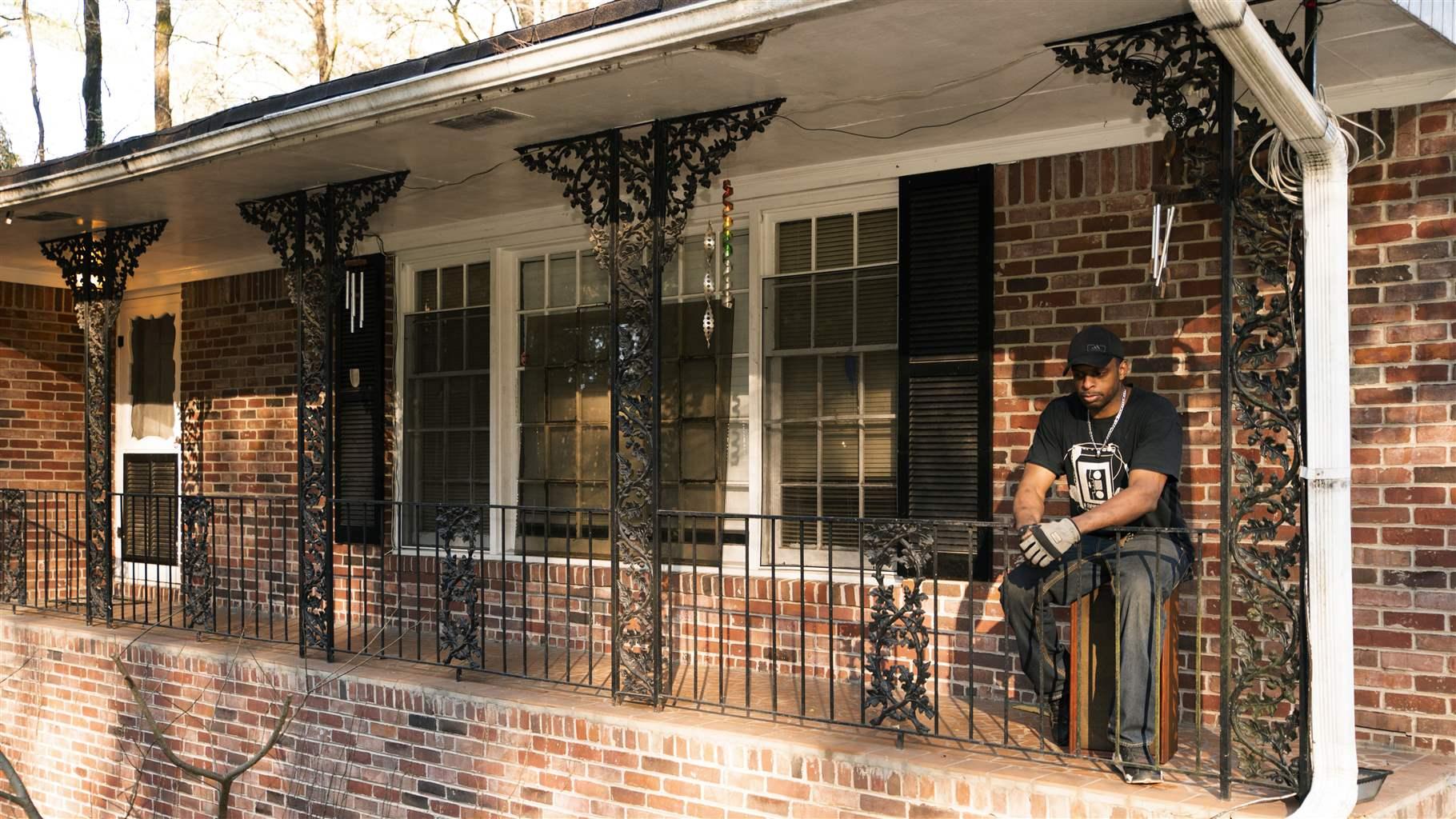

Investors Bought a Quarter of Homes Sold Last Year, Driving Up Rents
source link: https://www.pewtrusts.org/en/research-and-analysis/blogs/stateline/2022/07/22/investors-bought-a-quarter-of-homes-sold-last-year-driving-up-rents
Go to the source link to view the article. You can view the picture content, updated content and better typesetting reading experience. If the link is broken, please click the button below to view the snapshot at that time.
Investors Bought a Quarter of Homes Sold Last Year, Driving Up Rents

Navy veteran Prince Beatty sits on the porch of his home in the Atlanta suburb of East Point, Ga., where he faced eviction earlier this year after falling behind on his rent when it increased from $1,250 to $2,000. Investors have bought up rental homes, especially in Black and Hispanic suburbs in the Sun Belt, causing drops in home ownership. Hakim Wright Sr. The Associated Press
Investors bought nearly a quarter of U.S. single-family homes that sold last year, often driving up rents for suburban families in the process.
The issue is especially acute in some Sun Belt states amid evidence that investors often can outbid other buyers, keeping starter homes out of the hands of would-be owners, especially suburban Black and Hispanic families. Some local officials in those states are pushing for increased regulation of investor purchases, but many Republican lawmakers oppose such controls.
Investors bought 24% of all single-family houses sold nationwide last year, up from 15% to 16% annually going back to 2012, according to a Stateline analysis of data provided by CoreLogic, a California-based data analytics firm. That share dipped only slightly in the first five months of 2022 to 22%.
Investor purchases doubled or more in Florida, Nevada, Vermont and Washington state from 2020 to 2021. In Vermont, they grew from 7% of sales in 2020 to 17% last year and in Nevada from 18% to 30%.
Five states saw the highest share of investor purchases. Investors bought a third of single-family homes sold in Georgia (33%) last year, with Arizona (31%), Nevada (30%), California and Texas (both 29%) not far behind.
Investor ownership began to grow after the Great Recession of 2008-2009, when large swaths of overbuilt Sun Belt homes went into foreclosure, and investors snapped them up. Investor ownership grew again last year as pandemic-related demand for suburban housing rose, and investors saw a chance to win bidding wars with cash offers.
Investor Home Purchases Spiked in 2021
Investor share of home sales, 2021: 23%
Investor home sales, 2021: 23,015
Change from 2020: 46%
Investor share of home sales, 2021: 17%
Investor home sales, 2021: 2,249
Change from 2020: 37%
Investor share of home sales, 2021: 31%
Investor home sales, 2021: 61,201
Change from 2020: 76%
Investor share of home sales, 2021: 24%
Investor home sales, 2021: 14,481
Change from 2020: 35%
Investor share of home sales, 2021: 29%
Investor home sales, 2021: 126,354
Change from 2020: 90%
Investor share of home sales, 2021: 24%
Investor home sales, 2021: 33,995
Change from 2020: 89%
Investor share of home sales, 2021: 14%
Investor home sales, 2021: 5,910
Change from 2020: 56%
Investor share of home sales, 2021: 17%
Investor home sales, 2021: 3,182
Change from 2020: 67%
Investor share of home sales, 2021: 25%
Investor home sales, 2021: 1,318
Change from 2020: 59%
Investor share of home sales, 2021: 22%
Investor home sales, 2021: 115,989
Change from 2020: 100%
Investor share of home sales, 2021: 33%
Investor home sales, 2021: 87,333
Change from 2020: 90%
Investor share of home sales, 2021: 22%
Investor home sales, 2021: 2,403
Change from 2020: 68%
Investor share of home sales, 2021: 26%
Investor home sales, 2021: 16,159
Change from 2020: 14%
Investor share of home sales, 2021: 19%
Investor home sales, 2021: 30,865
Change from 2020: 71%
Investor share of home sales, 2021: 26%
Investor home sales, 2021: 42,648
Change from 2020: 44%
Investor share of home sales, 2021: 18%
Investor home sales, 2021: 11,557
Change from 2020: 32%
Investor share of home sales, 2021: 25%
Investor home sales, 2021: 12,673
Change from 2020: 31%
Investor share of home sales, 2021: 21%
Investor home sales, 2021: 16,879
Change from 2020: 34%
Investor share of home sales, 2021: 15%
Investor home sales, 2021: 10,656
Change from 2020: 46%
Investor share of home sales, 2021: 16%
Investor home sales, 2021: 3,192
Change from 2020: 54%
Investor share of home sales, 2021: 20%
Investor home sales, 2021: 21,336
Change from 2020: 88%
Investor share of home sales, 2021: 17%
Investor home sales, 2021: 11,027
Change from 2020: 81%
Investor share of home sales, 2021: 19%
Investor home sales, 2021: 28,573
Change from 2020: 38%
Investor share of home sales, 2021: 18%
Investor home sales, 2021: 19,582
Change from 2020: 77%
Investor share of home sales, 2021: 25%
Investor home sales, 2021: 8,420
Change from 2020: 04%
Investor share of home sales, 2021: 26%
Investor home sales, 2021: 41,834
Change from 2020: 39%
Investor share of home sales, 2021: 21%
Investor home sales, 2021: 5,168
Change from 2020: 32%
Investor share of home sales, 2021: 22%
Investor home sales, 2021: 8,600
Change from 2020: 50%
Investor share of home sales, 2021: 30%
Investor home sales, 2021: 23,995
Change from 2020: 110%
Investor share of home sales, 2021: 15%
Investor home sales, 2021: 2,682
Change from 2020: 41%
Investor share of home sales, 2021: 18%
Investor home sales, 2021: 22,878
Change from 2020: 67%
Investor share of home sales, 2021: 26%
Investor home sales, 2021: 11,135
Change from 2020: 47%
Investor share of home sales, 2021: 17%
Investor home sales, 2021: 26,649
Change from 2020: 66%
Investor share of home sales, 2021: 24%
Investor home sales, 2021: 58,393
Change from 2020: 85%
Investor share of home sales, 2021: 15%
Investor home sales, 2021: 2,335
Change from 2020: 51%
Investor share of home sales, 2021: 21%
Investor home sales, 2021: 32,945
Change from 2020: 47%
Investor share of home sales, 2021: 24%
Investor home sales, 2021: 20,049
Change from 2020: 52%
Investor share of home sales, 2021: 20%
Investor home sales, 2021: 16,781
Change from 2020: 67%
Investor share of home sales, 2021: 18%
Investor home sales, 2021: 32,820
Change from 2020: 68%
Investor share of home sales, 2021: 16%
Investor home sales, 2021: 2,015
Change from 2020: 70%
Investor share of home sales, 2021: 18%
Investor home sales, 2021: 21,936
Change from 2020: 60%
Investor share of home sales, 2021: 10%
Investor home sales, 2021: 205
Change from 2020: -53%
Investor share of home sales, 2021: 26%
Investor home sales, 2021: 42,818
Change from 2020: 55%
Investor share of home sales, 2021: 29%
Investor home sales, 2021: 208,964
Change from 2020: 63%
Investor share of home sales, 2021: 27%
Investor home sales, 2021: 20,541
Change from 2020: 26%
Investor share of home sales, 2021: 17%
Investor home sales, 2021: 2,384
Change from 2020: 150%
Investor share of home sales, 2021: 17%
Investor home sales, 2021: 28,020
Change from 2020: 78%
Investor share of home sales, 2021: 22%
Investor home sales, 2021: 27,559
Change from 2020: 102%
Investor share of home sales, 2021: 16%
Investor home sales, 2021: 3,293
Change from 2020: 22%
Investor share of home sales, 2021: 16%
Investor home sales, 2021: 16,896
Change from 2020: 57%
Investor share of home sales, 2021: 23%
Investor home sales, 2021: 3,285
Change from 2020: 31%
Across most states, investor purchases of homes spiked in 2021 and remained elevated in the early months of 2022. Investors made 29% or more of the home purchases last year in Arizona, California, Georgia, Texas and Nevada, and investor purchases doubled or more from 2020 for Florida, Nevada, Vermont and Washington.
Source: CoreLogic and Stateline analysis
The Sun Belt also appealed to investors because there are fewer statewide restrictions than in a state such as California, which heavily regulates landlord-tenant issues, said Jenny Schuetz, a housing policy expert at the Brookings Institution who has testified at congressional hearings on investor ownership of homes.
Local governments need help to identify problem landlords and write new regulations, she added, such as landlord registries and boilerplate lease language requirements that protect tenants.
“They’re not prepared to deal with this. We need to get more tools into their hands,” Schuetz said.
In North Las Vegas, Nevada, which is mostly Hispanic and Black, residents have gathered petitions for a ballot initiative limiting rent increases, saying they’ve been outbid by investors who have raised rent sharply in recent years.
The controls were supported by Democratic Gov. Steve Sisolak, who blamed “out-of-state speculators coming in buying up homes in our neighborhoods and raising the rent,” and says the North Las Vegas plan could become a template for statewide rent controls.
In Georgia, local officials are fighting for more regulation of rental homes, but some Republican lawmakers seek a more hands-off policy. GOP leaders in the legislature, joined by some Democrats, sponsored bills in February that would have preempted local regulation of landlords and rents.
The bills would have prohibited “any restrictions” by local government on rental housing, threatening to withhold state funding for violations. The legislation immediately drew protests from many cities and counties.
The state Senate and House bills both died in committee but could come back in another session, said Mayor Bianca Motley Broom of College Park, a mostly Black suburb south of Atlanta.
“It really has been one of the defining issues of the last couple of years,” Motley Broom said.
Most of her constituents are renters hoping to buy homes, and they were disappointed when a new development of more than 200 houses announced a change to “build to rent,” meaning the units would be long-term rentals, she said.
“Preemption laws tie our hands and essentially force 537 cities, each with unique dynamics, to be force-fed a cookie-cutter approach,” said Motley Broom.
Michael Malcolm, 65, said he struggled to find affordable rent in College Park as a retired, disabled telemarketing executive. When a landlord raised his rent from $750 to $1,500 two months ago, he found a relative with whom to share his three-bedroom house after searching in vain for something more reasonable.
“One house we looked at was fine when we looked at it. Our budget was $1,500, but then in two days, it went to $2,000,” he said. “It’s crazy. Yet there are people coming in and paying those rents.”
The Georgia Municipal Association, representing Georgia municipalities, opposes the preemption bills that were introduced, partly so that cities can decide for themselves about “build to rent” policies, said Charlotte Davis, the association’s deputy director of governmental relations, speaking at an Atlanta-area housing forum in June.
“This has been a very heavy-handed approach, going to the state legislature to preempt mayors and county commissions and ultimately local residents, because it’s easier to strong-arm the state,” Davis said.
Sponsors of the state bills did not return Stateline calls for comment.
Large-scale rental house landlords often are blamed for rent hikes but still represent a tiny portion of single-family homes, said David Howard, director of the National Rental Home Council in Washington, D.C., a trade group representing single-family home landlords.
“The idea that large, faceless, deep-pocketed out-of-town investors are taking over every housing market and dictating rents is just not true,” Howard said, speaking of what he called a half-dozen companies with tens of thousands of homes nationwide.
The CoreLogic data shows that what it calls “mega” investors, with a thousand or more homes, bought 3% of houses last year and in 2022, compared with about 1% in previous years, with the bulk of investor purchases made by smaller groups.
U.S. Rep. Tom Emmer, a Minnesota Republican, defended landlords at a U.S. House committee hearing on the issue of investor-owned homes in June. Racially diverse suburbs in Minnesota are among those targeted by investor home purchases, according to a report last year by the Minneapolis Federal Reserve Bank.
“We must not forget that single-family rental homes fill a gap for a large population of our country who either prefer or need to rent,” Emmer said. “We cannot demonize institutions for facilitating this supply of quality housing that otherwise would be out of reach for many Americans.”
Institutional buying in Georgia has focused on a ring of middle-class Black suburbs south of Atlanta, according to research by Brian An, an assistant professor of public policy at Georgia Tech. An said buying since 2007 was concentrated in southern Atlanta suburbs with mostly Black populations, low poverty, good schools and small affordable houses considered good starter homes.
Institutions began investing in Black and Hispanic neighborhoods near Atlanta when untenable subprime mortgages led to foreclosures after the Great Recession, said another Georgia Tech assistant professor, Elora Raymond. Raymond’s studies found investor ownership in some Atlanta-area neighborhoods led to evictions, gentrification and displacement of longtime Black residents as investors sought higher-income renters who could pay more rent to boost profits.
Schuetz said investor ownership may not be a bad thing in itself, if landlords treat tenants well. Investor interest in houses is a symptom of a larger problem — low supply of houses, she stressed.
“If 50 people are bidding for a house, 49 are going to lose, but they still need a place to live,” Schuetz said.
She said states and localities could create landlord registries, like one adopted last year by Los Angeles County to help local governments recognize which corporations or other investors have patterns of abusing tenants with quick evictions or excessive fees, or who neglect property maintenance.
States and cities could increase legal protections for tenants, since some professional landlords have been quick to evict when tenants fall behind on rent, said Desiree Fields, a University of California, Berkeley associate professor who studies single-family rental issues.
“The states where investor ownership [of rental homes] is most prominent are also states where there are hardly any tenant protection measures,” Fields said.
AUTHORs
Daily update — original reporting on state policy, plus the day's five top reads from around the web.
Weekly newsletter—our best original reporting and analysis every Monday.
USE OUR STORIES AND GRAPHICS
All Stateline stories and graphics may be republished in print or online for free. All we ask is that you follow a few rules:
- All Stateline stories are licensed under a Creative Commons Attribution-Noncommercial-NoDerivatives 4.0 International License (CC-BY-NC-ND 4.0).
- Attribute stories to “Stateline, an initiative of The Pew Charitable Trusts.”
- Stateline material may only be edited or changed for style reasons or to shorten for length.
- Any use online should include a link back to our website.
- Follow Pew’s Terms and Conditions.
Recommend
About Joyk
Aggregate valuable and interesting links.
Joyk means Joy of geeK


 Historic Climate Law Includes Major Investments in Nature-Based Solutions
Historic Climate Law Includes Major Investments in Nature-Based Solutions
 'Lifeblood' of Western Australian Valley Under Threat
'Lifeblood' of Western Australian Valley Under Threat
 New Therapy Shows Promise for Metastatic Skin Cancer
New Therapy Shows Promise for Metastatic Skin Cancer